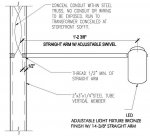A new patio shade structure is framed in 2"x3" structural tube steel. It's welded together and supported from the front facade of the building.
The architect requests to route wiring inside the tube steel. It would enter the steel at the building wall, then make 90s down to a vertical member, then turn another 90 thru a threaded nipple. It would then power a small LED luminaire head - see detail.
My questions:
The wiring will probably be low voltage (12V) but I'm curious if you see any difference with line voltage.
Thanks for your thoughts - I'm just a stupid engineer and don't have the field experience of your smart minds. As always, code references are appreciated.
As always, code references are appreciated.
The architect requests to route wiring inside the tube steel. It would enter the steel at the building wall, then make 90s down to a vertical member, then turn another 90 thru a threaded nipple. It would then power a small LED luminaire head - see detail.
My questions:
- Is this code compliant? Since it's not in a listed raceway I was assuming to use cable, perhaps MC or SO (Article 400). Can you think of any code concerns?
- Is this buildable? I was thinking the sharp edges of the weld could damage the pull, assuming you could actually fish it thru. Maybe installing a jbox at the top of the vertical member would be much better - this way there's only one 90, i.e. the last bend thru the threaded nipple in the detail.
The wiring will probably be low voltage (12V) but I'm curious if you see any difference with line voltage.
Thanks for your thoughts - I'm just a stupid engineer and don't have the field experience of your smart minds.


